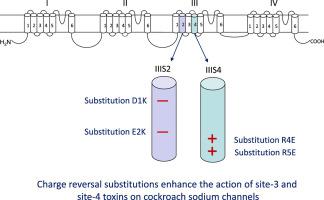Insect Biochemistry and Molecular Biology ( IF 3.2 ) Pub Date : 2021-08-03 , DOI: 10.1016/j.ibmb.2021.103625 Qing Zhu 1 , Yuzhe Du 2 , Yoshiko Nomura 2 , Rong Gao 3 , Zixuan Cang 4 , Guo-Wei Wei 4 , Dalia Gordon 5 , Michael Gurevitz 5 , James Groome 6 , Ke Dong 7

|
Scorpion α-toxins bind at the pharmacologically-defined site-3 on the sodium channel and inhibit channel inactivation by preventing the outward movement of the voltage sensor in domain IV (IVS4), whereas scorpion β-toxins bind at site-4 on the sodium channel and enhance channel activation by trapping the voltage sensor of domain II (IIS4) in its outward position. However, limited information is available on the role of the voltage-sensing modules (VSM, comprising S1–S4) of domains I and III in toxin actions. We have previously shown that charge reversing substitutions of the innermost positively-charged residues in IIIS4 (R4E, R5E) increase the activity of an insect-selective site-4 scorpion toxin, Lqh-dprIT3-c, on BgNav1-1a, a cockroach sodium channel. Here we show that substitutions R4E and R5E in IIIS4 also increase the activity of two site-3 toxins, LqhαIT from Leiurusquinquestriatus hebraeus and insect-selective Av3 from Anemonia viridis. Furthermore, charge reversal of either of two conserved negatively-charged residues, D1K and E2K, in IIIS2 also increase the action of the site-3 and site-4 toxins. Homology modeling suggests that S2-D1 and S2-E2 interact with S4-R4 and S4-R5 in the VSM of domain III (III-VSM), respectively, in the activated state of the channel. However, charge swapping between S2-D1 and S4-R4 had no compensatory effects on gating or toxin actions, suggesting that charged residue interactions are complex. Collectively, our results highlight the involvement of III-VSM in the actions of both site 3 and site 4 toxins, suggesting that charge reversing substitutions in III-VSM allosterically facilitate IIS4 or IVS4 voltage sensor trapping by these toxins.
中文翻译:

结构域 III 的电压传感模块的电荷取代增强了位点 3 和位点 4 毒素对昆虫钠通道的作用
蝎子 α 毒素结合在钠通道上药理学定义的位点 3 处,并通过阻止 IV 域 (IVS4) 中电压传感器的向外运动来抑制通道失活,而蝎子 β 毒素结合在钠通道上的位点 4 上通道并通过将域 II (IIS4) 的电压传感器捕获在其外部位置来增强通道激活。然而,关于域 I 和 III 的电压传感模块(VSM,包括 S1-S4)在毒素作用中的作用,可获得的信息有限。我们之前已经表明,IIIS4(R4E、R5E)中最内部带正电荷的残基的电荷反转取代增加了昆虫选择性位点 4 蝎子毒素 Lqh-dprIT 3- c 在 BgNa v 1-1a 上的活性,蟑螂钠通道。在这里,我们发现 IIIS4 中的 R4E 和 R5E 取代也增加了两种位点 3 毒素的活性,即来自Leurusquinquestriatus hebraeus的 LqhαIT 和来自Anemonia的昆虫选择性 Av3 绿色。此外,IIIS2 中两个保守的带负电荷的残基 D1K 和 E2K 中任一个的电荷反转也会增强位点 3 和位点 4 毒素的作用。同源建模表明,在通道激活状态下,S2-D1 和 S2-E2 分别与结构域 III (III-VSM) 的 VSM 中的 S4-R4 和 S4-R5 相互作用。然而,S2-D1 和 S4-R4 之间的电荷交换对门控或毒素作用没有补偿作用,表明带电残基相互作用是复杂的。 总的来说,我们的结果强调了 III-VSM 参与位点 3 和位点 4 毒素的作用,表明 III-VSM 中的电荷反转取代在变构上促进了 IIS4 或 IVS4 电压传感器被这些毒素捕获。











































 京公网安备 11010802027423号
京公网安备 11010802027423号